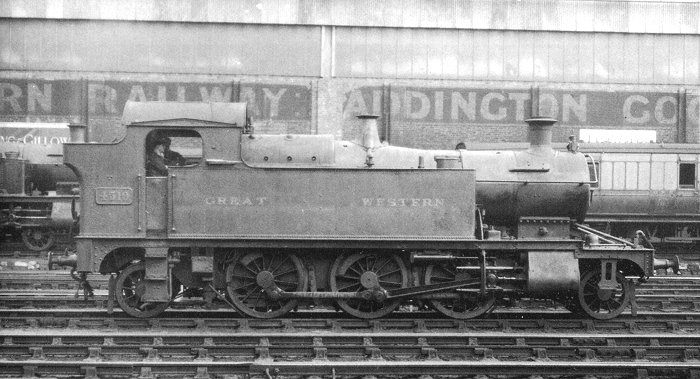
The very last locomotive to be
built at Stafford Road Works was 2-6-2T No 4519, which
was completed in April 1908, and it is seen here at
Paddington, circa 1920. This 2-6-2T would eventually be
withdrawn from service in February 1959. Author's
Collection. |
|
Wolverhampton-built
locomotives
A detailed history of the
construction and rebuilding of locomotives at the
Stafford Road Works, and the differences from those
built at Swindon, would easily require a complete book
in itself to do the subject full justice, so this is an
overview. The newly formed GWR Northern Division had
come about by way of a series of amalgamations with
other smaller railway companies, and the locomotives and
stock that was acquired was extremely varied, to say the
least, as there were few alike. At first the policy had
to be one of repair and rebuilding wherever possible,
and as a result it was not until 1859 that Stafford Road
Works managed to build its first completely new
locomotive, followed by another two during 1860 and
1862.
The Works capacity for new builds
had been made even worse on the assimilation of the
extra West Midland Railway stock in 1863, but
nonetheless this difficult situation was accepted and
dealt with. After Joseph Armstrong moved down to Swindon
in 1864, his brother George Armstrong then had to
continue with what was almost a constant 'make and mend'
policy, bringing into use standard boilers, parts,
cylinders, and other elements of construction whenever
possible. As a result, it took some years before the
regular construction of new locomotives could be moved
forward to any extent, due to the fact that the Works
was hard pressed just to maintain its eclectic
collection of locomotives, let alone find the time to
build new ones. |
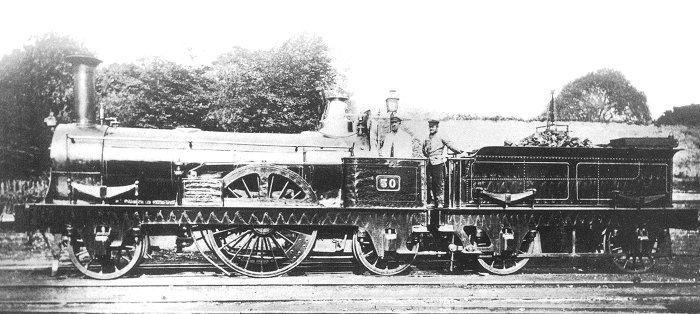
No 30 was a 2-2-2 Single
constructed at Wolverhampton (Works No 3) in September
1860. It incorporated outside bearings for the carrying
wheels and inside bearings only for the main driving
wheels. Records indicate that the firebox used was from
the ex-Shrewsbury & Chester Railway locomotive it
replaced. The driving wheel diameter was 6ft 6in, and
the leading and trailing wheels were 4ft 0in. Seen
coupled to its original four-wheel tender, in time this
locomotive would receive weather boards and a cab. On
the footplate is driver Thomas Smith, who in August 1864
began work as the first (and at the time the only)
driver on the line between Market Drayton and Nantwich,
which was a section on the Wellington to Crewe line. The
paintwork of the locomotive and tender is covered in
tallow wax, which, whilst affording protection, leaves a
permanent smear, and any changes in the direction of the
application was thus noticeable. The men made use of
this effect in order to create various patterns, and
this technique was known as 'givering'. Author's
Collection. |
|
It soon became clear that an
extension of the Works was now an urgent requirement,
and so the Works was expanded as quickly as possible
within the area of land that was available. The first
new locomotive built to a George Armstrong design
eventually appeared in 1866, amidst the never ending
maintenance and rebuilds of the other locomotives.
Despite these adverse conditions,
as from 1866 onwards, construction of new engines at
Stafford Road Works increased rapidly, which were, in
the main, various classes of small 0-6-0Ts or 0-4-2Ts,
with the surprise exception of six '3226' class 2-4-0
tender engines for passenger use, which appeared in
1889. By way of example, there were 170 locomotives that
comprised the '850' and '1901' classes of 0-6-0Ts built
at the Works in fourteen lots between 1874 and 1895, and
which were in essence to become the 'stock in trade' of
Wolverhampton Works for some thirty years. The well
known '517' class 0-4-2Ts, which comprised some 156
engines, were all built at Stafford Road Works over a
period of years from 1868 to 1885, and there were also a
number of 'one-off' 0-4-0STs and 0-4-0ST rebuilds.
Alongside all of this construction
work, however, many larger passenger locomotives and
other types of engines were being built as 'renewals'.
In the latter case there were large numbers of 2-2-2 and
2-4-0 tender engines (even some whole classes) that were
formally designated as 'renewals', although in reality
almost nothing of the original locomotive actually
remained in the finished Stafford Road product. These
were termed 'Accountant's Rebuilds', and as such no
actual Works numbers were given to them. |
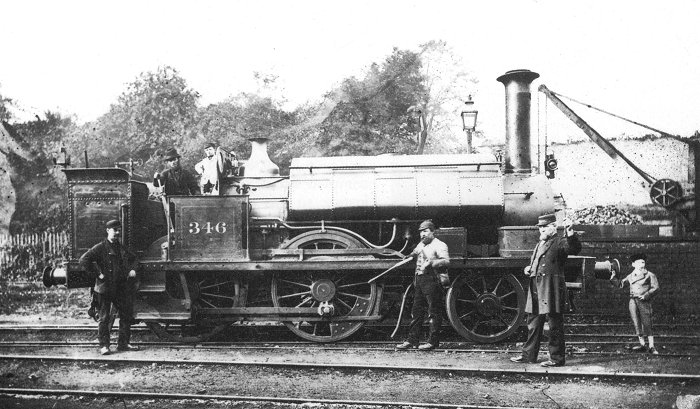
An early photograph of
Wolverhampton-built 2-4-0 No 346 of 1865. Shortly after
George Armstrong took over as Manager of the Stafford
Road Works he had twelve small 2-4-0 engines built,
which appeared during the period 1864 to 1866. These
engines were not all of a uniform class, but were
nonetheless alike in many respects as to frame, firebox,
and boiler construction. Originally built as back or
well tanks, they proved to be unsatisfactory in this
form and so they were all converted to saddle tanks
within a few years. No 346, completed in December 1865,
is seen here following its conversion at the Works to
saddle tank form during 1867. Author's Collection. |
|
The Wolverhampton
Style
It is worth noting that the wide
independence which the GWR Northern Division established
at Wolverhampton was evidenced by many features. George
Armstrong soon developed what became known as 'The
Wolverhampton Style'. For a long time the Stafford
Road-built locomotives were even painted in a different
style to those at Swindon, harking back to the days of
the Oxford, Worcester & Wolverhampton Railway livery. In
relation to Wolverhampton locomotive colour schemes, it
is difficult to be absolutely precise on this subject as
there are only limited sources for this information,
which sometimes tend to differ. However, on a general
basis the Wolverhampton livery as noted from 1880 was a
blue-green colour with black boiler bands, with borders
and panelling lined out in white. Outside frames and
wheels were in a dark purple brown, edged in black and
picked out in red. Wheel bosses were bordered with black
rings, with a red line around each edge. However, from
about 1894 Wolverhampton started to adopt the
Swindon-style GWR green livery, but no doubt it would
have taken some time for full conformity with Swindon to
be established at Wolverhampton.
Apart from colour schemes and
distinctive lining-out patterns, there were also
numerous obvious detail differences. By way of example,
Wolverhampton-built (or rebuilt) locomotives were often
fitted with a distinctive 'roll-top' chimney, and there
were also smokebox 'wing-plates' (on some classes of
0-4-2Ts), typical Wolverhampton-style cabs and also
spectacle plates, and flat or dished smokebox doors. In
the early years, very distinctive L&NWR-style cast-iron
'H' -section wheels were fitted to certain classes of
0-6-0STs. Wolverhampton Works was justifiably proud of
the individuality of its locomotives from the
Swindon-built products and strived to maintain this
situation for as long as possible, and there was always
some degree of rivalry with its Swindon counterpart. |
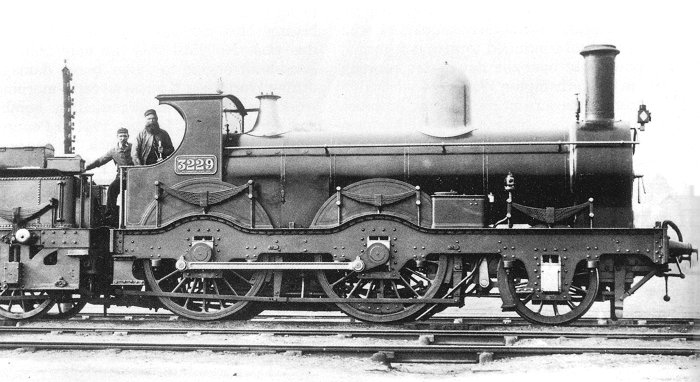
The '3226' class locomotive No
3229 is shown here as built in 1889 with a flush firebox
casing and Wolverhampton type chimney. No 3229 was one
of the six locomotives that formed the whole of the
class, and these were the last tender engines to be
built at the Stafford Road Works. Author's Collection. |
|
George Armstrong retired in 1896,
and during his 33 years in charge, Wolverhampton Works
had built 627 new locomotives and rebuilt a further 513
engines. J. A. Robinson was then appointed as the
Northern Division Locomotive Superintendent to carry on
the work from 1897 up until 1918. It was during the
course of his superintendency that the last two Lots of
locomotives actually to be built at Stafford Road Works
were completed and turned out during 1905 and 1906,
after which time the building of new engines at
Wolverhampton ceased altogether.
Over thirty years passed, during
which time the Works was only able to deal with
locomotive repairs falling within its capacity. It was
not until 1932, when the major and final expansion of
the Works premises had been completed, that
Wolverhampton was to some extent restored to the front
rank, so as to speak, able to cope with the heaviest of
the GWR locomotives, which remained the case up to its
official closure.
At one stage the Stafford Road
Factory (as it was locally known) had earned itself the
nickname of 'The Museum' as a result of the collection
of old-style Cambrian Railways or Dean 0-6-0s that would
often be found there awaiting attention, together with
the various old-style Wolverhampton saddle tanks and
other oddities.
With the opening of the new locomotive shed at Oxley in
1907 (mainly for goods engines), the engine shed at
Stafford Road then catered only for the larger passenger
locomotives, shed No 2 becoming a tank repair shop,
later falling, as did No 3 shed, into disrepair.
However, as the years went by a general mixing of both
goods and mixed traffic locomotives became the case at
both Oxley and Stafford Road sheds, apart from the
Wolverhampton-allocated 'King' class locomotives that
were always the province of Stafford Road shed. |
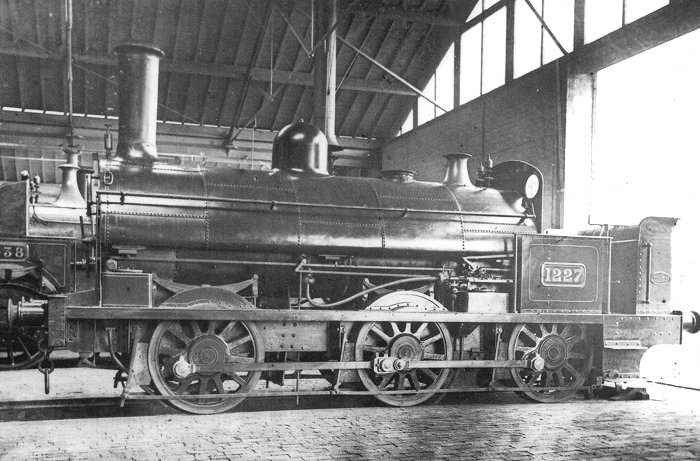
Wolverhampton-built '850' class
0-6-0T No 1227 is seen at Stafford Road, circa 1880, as
built in 1877. Author's Collection. |
|
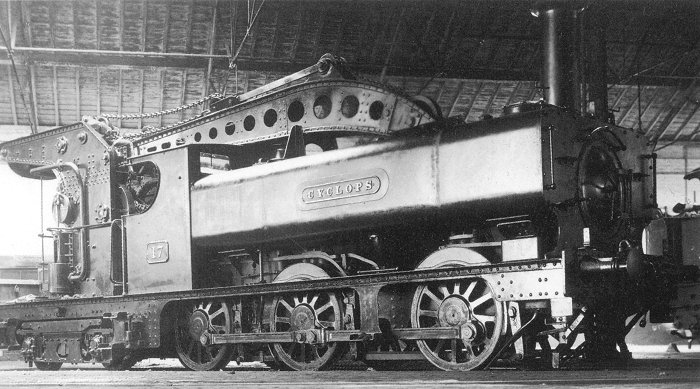
Crane engines Nos 17 and 18 were
built at Swindon Works in 1901, but they were in effect
based on the Wolverhampton designed '850' class tanks,
with the rear frame extended backwards to accommodate
the steam crane. Even the wheels were of the
Wolverhampton 'H'-section pattern.
No 17 Cyclops was attached to
Stafford Road Works from 1903 onwards and (among other
locations) was once photographed in 1914 on the Brunel-designed
twin tubular bridges which crossed the adjacent canal, a
section of the double bridge that provided the access to
a separate coaling plant. No 17 Cyclops is seen here on
shed at Stafford Road. In due course, in March 1934,
Cyclops would be transferred from its duties at
Wolverhampton to Swindon, with this locomotive
eventually being withdrawn in September 1936. Author’s
Collection. |
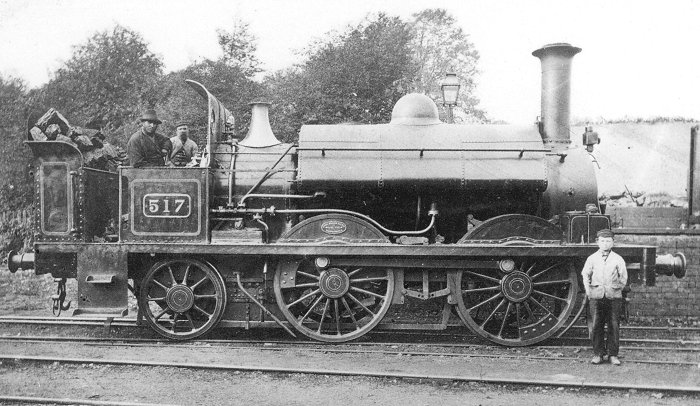
Apart from its 0-6-0Ts,
Wolverhampton Works also produced saddle tanks and side
tanks of other wheel arrangements. Whilst Swindon
adhered to the 2-4-0T arrangement, Wolverhampton is
remembered in particular for its useful 0-4-2Ts of the
'517' class, which comprised some 156 engines built from
1868 to 1885. Throughout their construction they were
improved and modified in preference to being replaced
with new engines. The head of the class, No 517, is seen
in its original condition. The first thirty or so of
these engines were built as saddle tanks, but all of the
'517s' ended up as side tanks, and the last survivor, No
1163, would be withdrawn in May 1946. A further ten
0-4-2Ts were built during 1895, known as the '3571'
class. These were a development of the '517s' and were
the first Wolverhampton engines to be fitted with
Dean-type chimneys from new. The last engine of this
class in use was No 3574, which would not be withdrawn
until December 1949. Author's Collection. |
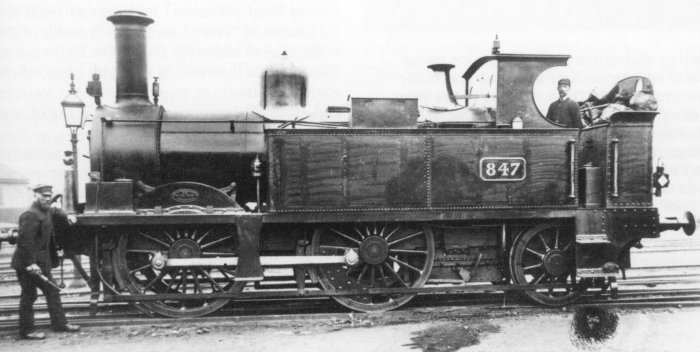
The '517' class 0-4-2T No 847 was
completed at Wolverhampton Works in February 1875.
During the 19th century these engines were employed on
branch line and local work, especially in the Northern
Division, and were used for most of the suburban work in
the Wolverhampton and Birmingham areas. No 847 would
ultimately be withdrawn in May 1933. Author's
Collection. |
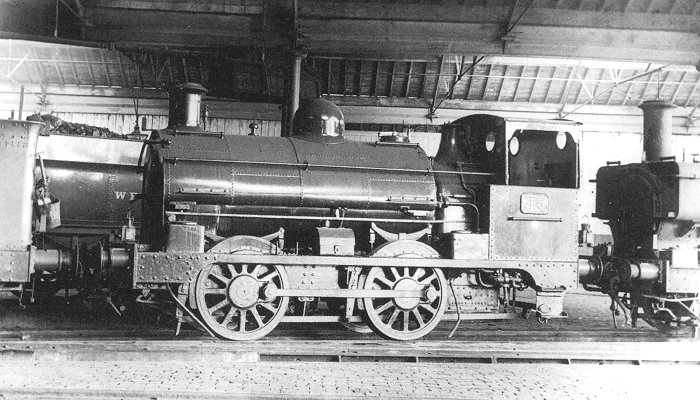
The 0-4-0ST No 45 was completed at
Wolverhampton in June 1880, and it was the only 0-4-0ST
of a conventional design to be built at a GWR Works. It
was constructed as a replacement for an old four-coupled
engine that was inherited from the Shrewsbury &
Birmingham Railway, and it would not be withdrawn until
April 1938. Author's Collection. |
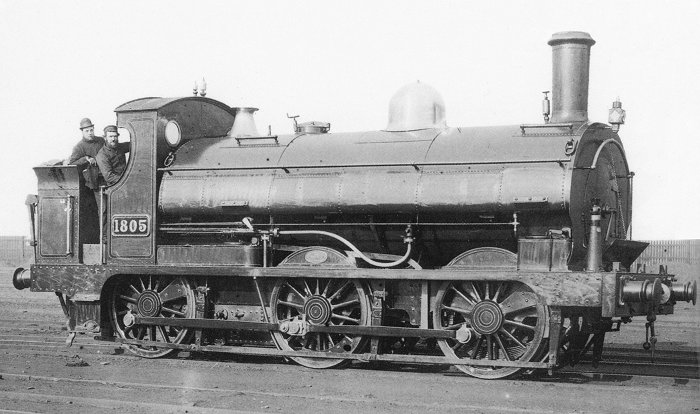
An example of a typical
Wolverhampton saddle tank locomotive. This '1501' class
0-6-0PT, No 1805, was built at the Stafford Road Works
in 1881, and it is seen here, circa 1890, in the later
style of Wolverhampton livery. The above frame lining
out of the cabside and coal bunker can clearly be seen,
as can the typical Stafford Road application of
decreasing circles on the wheel centres. Author’s
Collection. |
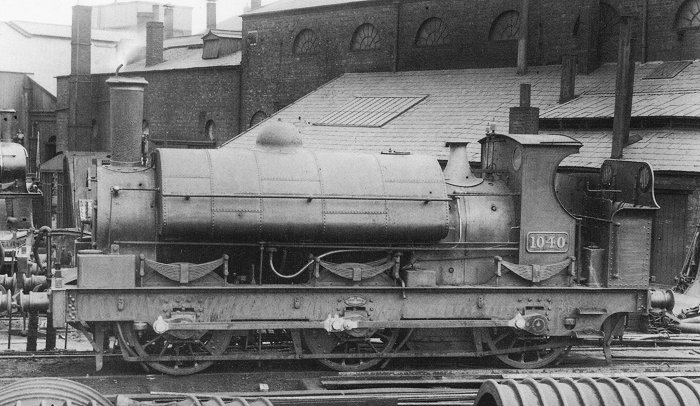
Wolverhampton-built '1016' class
0-6-0ST No 1040 is pictured against the backdrop of
Stafford Road Works, circa 1890. The Wolverhampton style
of rolled-top chimney and a rear spectacle plate are in
evidence. These spectacle plates were a characteristic
Wolverhampton feature that appeared in various forms
from the 1860s onwards, with or without glasses,
examples of which could still be found well into the
1930s. Author’s Collection. |
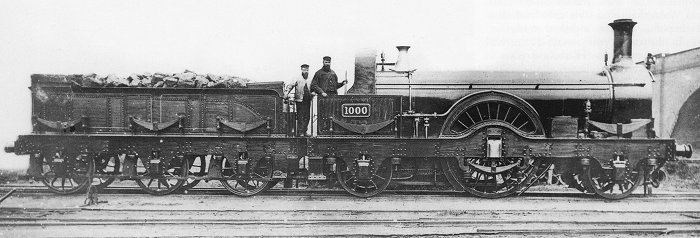
The 'Queen' class 2-2-2 No 1000
was allocated to Wolverhampton, the engine being seen
here in the yard at Stafford Road while fitted with an
intermediate style cab and other Wolverhampton fitments.
E .L. Ahrons, writing in Locomotive and Train Working in
the latter part of the 19th century, said 'I travelled
hundreds of miles on the footplates of most of the 7ft
Singles, and the Wolverhampton engines were certainly
the better for both pulling and running. On the 4.45pm
(from Paddington) they gave me a large number of
excellent performances, the best of which was by engine
No 1000 (Driver Hamer) which ran from Oxford to
Birmingham with 120 tons, 65.718 miles in 69 minutes 50
seconds at an average speed of 56½ miles per hour. No
1000 was finally withdrawn in September 1906'.
The Swindon-built 'Queen' class
numbered some 21 locomotives that sprang from a single
engine, No 55 of September 1873, Queen herself (as the
name suggests) being often used on Royal trains, on
which duty it was adorned with a large detachable plaque
carrying the Royal Coat of Arms in brass. In due course
'Queen' class locomotives were variously modified and
rebuilt at Wolverhampton Stafford Road Works with new
boilers, closed-in splashers, and other
Wolverhampton-style features. These engines initially
worked expresses from London to Swindon and Gloucester,
and also to Wolverhampton. No 999 Sir Alexander,
together with Nos 1000, 1116, 1121, and 1127, were
allocated to Wolverhampton. By the turn of the century
they were employed mainly on the Wolverhampton
expresses. However, by 1904 the 'Queens' had become
obsolete and so they were relegated to secondary duties
from Oxford and Swindon. Authors Collection. |
|
Post-1929
It was in 1929, funded by a
Government grant, that the GWR prepared plans to
rebuild and enlarge the Wolverhampton Works, but
this time on a smaller scale than had originally
been envisaged back in 1905. Eventually completed in
1932, a new Works building was constructed on the
west side of the Victoria Basin line, containing
erecting equipment, machine and wheel turning shops,
the old erecting shops being converted to boiler
testing and tube repair shops. The rest of the old
shops were either stripped or converted for minor
uses, so that little then remained but the shell of
the old Locomotive Works. The old brass foundry,
smithy, and forge were kept on, and also a
spring-preparing furnace and a stripping press were
added to the smithy.
The new building was 450ft long
x 196ft wide and was arranged in three bays, two
forming the erecting shop and the third was for the
machine and wheel shops. Each of the erecting shop
bays was equipped with two fifty-ton overhead
cranes, and the machine shop had a six-ton crane.
Across the width of the
southern end of the new building extended an
electric traverser, onto which locomotives entering
the Works for repair were drawn up by the pilot
locomotive, and then moved across to the end of the
relevant road and into the building through the
large doors within one of the loftier of the three
gables forming the structure. Once inside, engines
would be stripped and successively moved along the
line as they were overhauled and re-assembled.
Following release at the building's northern end,
repaired engines then entered the weighbridge house
where, on separate scales for each axle, the weight
distribution of the locomotive could be adjusted by
tightening or loosening the spring-hanger nuts. Also
at the south end was a tank shop, and outside was a
six-ton 'Goliath' crane with a span of 75ft. Parts
requiring no repairs, and removed earlier from
locomotives about to undergo their refitting, were
also stored here. On the eastern side of the
building was a new boiler house containing two
Lancashire boilers with automatic stokers for
heating the shops. |
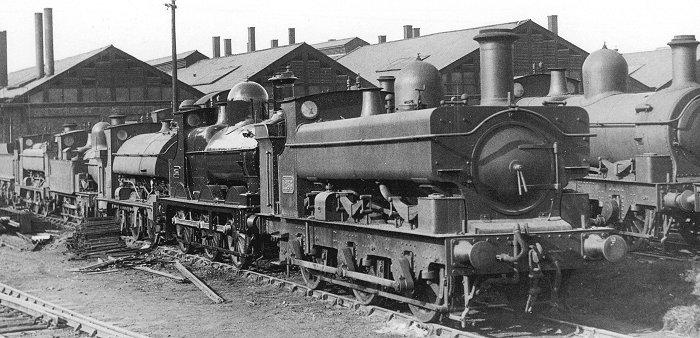
A view from the Fox's Lane
(south) end of the yard on 24 April 1932. The
roundhouses provide the backdrop, their use having
changed since the opening of the nearby Oxley shed
in 1907, with the No 2 shed here going on to become
a tank repair shop. At the head of the line of
locomotives is No 1253, an outside-framed 0-6-0PT,
with 'Dean Goods' 0-6-0 No 2551 behind; newly
outshopped from the Works, the 'Dean Goods' is
without its tender. Next in line is No 2107, a
Wolverhampton-built '2101' class saddle-tank,
followed by a 'Metro' class 2-4-0T, No 973. At the
rear is another Stafford Road-built engine, No 2120.
H. C. Casserley. |
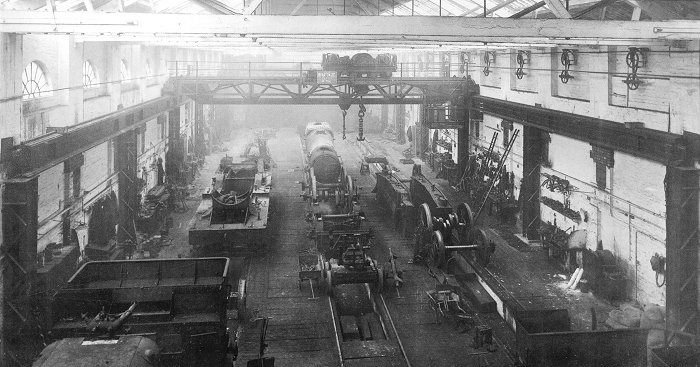
A circa 1932 scene from inside
the soon to be superseded erecting shop of the lower
part of the now growing Stafford Road Works site.
What appears to be the boiler of a 'Castle' class
4-6-0 can be seen on the centre road, with a
stripped down 2-4-0 to the left and various sections
of a 2-6-2T to the right. A far from ideal working
environment, even the walls of the building are
grime-encrusted from years of locomotive work. The
much brighter, loftier and roomy facilities on the
other side of the Victoria Basin line would be under
construction as this view was photographed. Author's
Collection. |
 |
|
 |
Return to
part 1 |
|
Proceed to
part 3 |
|